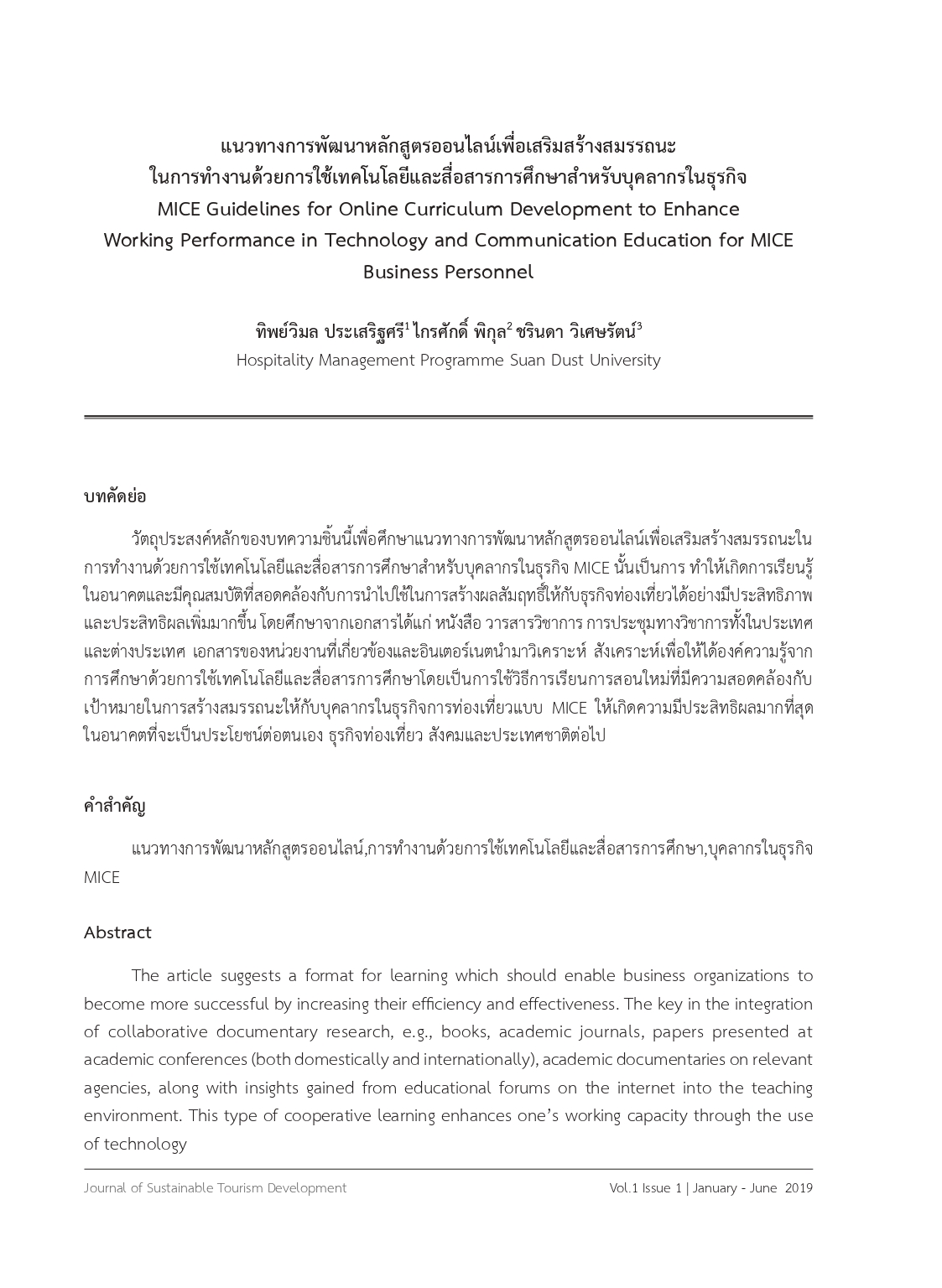แนวทางการพัฒนาหลักสูตรออนไลน์เพื่อเสริมสร้างสมรรถนะในการทำงานด้วยการใช้เทคโนโลยีและสื่อสารการศึกษาสำหรับบุคลากรในธุรกิจ MICE
Main Article Content
บทคัดย่อ
วัตถุประสงค์หลักของบทความชิ้นนี้เพื่อศึกษาแนวทางการพัฒนาหลักสูตรออนไลน์เพื่อเสริมสร้างสมรรถนะในการทำงานด้วยการใช้เทคโนโลยีและสื่อสารการศึกษาสำหรับบุคลากรในธุรกิจ MICE นั้น เป็นการทำให้เกิดการเรียนรู้ในอนาคตและมีคุณสมบัติที่สอดคล้องกับการนำไปใช้ในการสร้างผลสัมฤทธิ์ให้กับธุรกิจท่องเที่ยวได้อย่างมีประสิทธิภาพและประสิทธิผลเพิ่มมากขึ้น โดยศึกษาจากเอกสารได้แก่ หนังสือ วารสารวิชาการ การประชุมทางวิชาการทั้งในประเทศและต่างประเทศ เอกสารของหน่วยงานที่เกี่ยวข้องและอินเตอร์เนตนำมาวิเคราะห์ สังเคราะห์เพื่อให้ได้องค์ความรู้จากการศึกษาด้วยการใช้เทคโนโลยีและสื่อสารการศึกษาโดยเป็นการใช้วิธีการเรียนการสอนใหม่ที่มีความสอดคล้องกับเป้าหมายในการสร้างสมรรถนะให้กับบุคลากรในธุรกิจการท่องเที่ยวแบบ MICE ให้เกิดความมีประสิทธิผลมากที่สุดในอนาคตที่จะเป็นประโยชน์ต่อตนเอง ธุรกิจท่องเที่ยว สังคมและประเทศชาติต่อไป
Article Details

อนุญาตภายใต้เงื่อนไข Creative Commons Attribution-NonCommercial-NoDerivatives 4.0 International License.
ลิขสิทธิ์ต้นฉบับที่ได้รับการตีพิมพ์ในวารสารเพื่อการพัฒนาการท่องเที่ยวสู่ความยั่งยืน ถือเป็นกรรมสิทธิ์ของโรงเรียนการท่องเที่ยวและการบริการ มหาวิทยาลัยสวนดุสิต ห้ามผู้ใดนำข้อความทั้งหมดหรือบางส่วนไปพิมพ์ซ้ำ เว้นแต่จะได้รับอนุญาตอย่างเป็นลายลักษณ์อักษรจากโรงเรียนการท่องเที่ยวและการบริการ มหาวิทยาลัยสวนดุสิต นอกจากนี้ เนื้อหาที่ปรากฎในบทความเป็นความรับผิดชอบของผู้เขียน ทั้งนี้ไม่รวมความผิดพลาดอันเกิดจากเทคนิคการพิมพ์
เอกสารอ้างอิง
จตุพล ยงศร. (2554). นโยบายการพัฒนาคุณภาพการศึกษาของประเทศในประชาคมอาเซียน. วารสารสุโขทัยธรรมธิราช. 24 (1), 43-58.
จินตวีร์ คล้ายสังข์. (2554). หลักการออกแบบเว็บไซต์ทางการศึกษา: ทฤษฎีสู่การปฏิบัติ. กรุงเทพฯ: โครงการตำราอีเลิร์นนิง. โครงการมหาวิทยาลัยไซเบอร์ไทย. สำนักงานคณะกรรมการการอุดมศึกษา.
จิรุตถ์ อิศรางกูร ณ อยุธยา. (2562). ธุรกิจไมซ์ไทยปี 62. สืบค้น 2 มกราคม 2563, จาก http://www.brandage.com/article/10477/TCEB.
ชวนิดา สุวานิช. (2555). รายงานการวิจัยการพัฒนารูปแบบการเรียนรู้แบบเคลื่อนที่ผ่านเครื่องช่วยงานดิจิทัลส่วนบุคคล. กรุงเทพฯ: สถาบันวิจัยและพัฒนา, มหาวิทยาลัยราชภัฎจันทรเกษม.
ธนพล รุ่งเรือง และ โชคชัย สุเวชวัฒนกูล. (2558). สมรรถนะบุคลากรในอุตสาหกรรมไมซ์และความภักดีของผู้เข้าร่วมกิจกรรม. วารสารวิชาการการท่องเที่ยวไทยนานาชาติ. 11(2), 116-147.
ศูนย์สื่อการสอนทางอิเล็กทรอนิกส์ มหาวิทยาลัยรามคำแหง. (2560). E-learning คืออะไร. สืบค้น 10 กันยายน 2562, จาก http://www.ram.edu/elearning/what_e_learning.php
สุพรรณี ชาญประเสริฐ. (2556). การจัดการเรียนรู้วิทยาศาสตร์และทักษะที่จำเป็นในศตวรรษที่ 21. สถาบันส่งเสริมการสอนวิทยาศาสตร์และเทคโนโลยี (สสวท.), 42(185), 10-13.
สุวรรณา ตรงต่อศักดิ์ และ ปณิตา วรรณพิกุล. (2561).กระบวนการบริหารหลักสูตรตามกรอบมาตรฐานคุณวุฒิระดับอุดมศึกษาในมหาวิทยาลัยด้วยธุรกิจอัจฉริยะ.วารสารมนุษยศาสตร์และสังคมศาสตร์มหาวิทยาลัยราชพฤกษ์. ฉบับเสริมครบรอบ 12 ปีมหาวิทยาลัยราชพฤกษ์ (ธันวาคม 2561) :45 – 54.
สำนักงานการจัดการศึกษาออนไลน์. (2554). โครงการประกวดการจัดระบบอีเลิร์นนิงในระดับอุดมศึกษา ประจำปี 2554. กรุงเทพฯ: สำนักการจัดการศึกษาออนไลน์, มหาวิทยาลัยศรีปทุม.
สำนักงานคณะกรรมการการศึกษาแห่งชาติ. (2560). พระราชบัญญัติการศึกษาแห่งชาติ พ.ศ. 2542แก้ไขเพิ่มเติม (ฉบับที่ 2) พ.ศ. 2545 และ (ฉบับที่ 3) พ.ศ. 2553. กรุงเทพฯ: สำนักวิชาการและมาตรฐานการศึกษา.
สำนักงานคณะกรรมการการศึกษาแห่งชาติ. (2560). พระราชบัญญัติการศึกษาแห่งชาติ พ.ศ. 2542และที่แก้ไขเพิ่มเติม (ฉบับที่ 2) พ.ศ. 2545. กรุงเทพฯ: พริกหวานกราฟฟิค.
สำนักงานคณะกรรมการพัฒนาการเศรษฐกิจและสังคมแห่งชาติ. (2560). แผนพัฒนาเศรษฐกิจและสังคมแห่งชาติ ฉบับที่ สิบเอ็ด พ.ศ.2555-2559. กรุงเทพฯ: สำนักนายกรัฐมนตรี.
สำนักงานส่งเสริมการจัดประชุมและนิทรรศการ (องค์การมหาชน). 2557. ความรู้เบื้องต้นอุตสาหกรรมไมซ์ โอกาสการต่อยอดธุรกิจของผู้ประกอบการไทยสู่อุตสาหกรรมไมซ์. กรุงเทพฯ: สำนักงานส่งเสริมการจัดประชุมและนิทรรศการ (องค์การมหาชน).
Aimee de Noyelles & Ryan Seilhamer. (2015). Facilitating professional development of mobile and eTextbook technologies: A special interest group approach. Journal of Applied Research in Higher Education, 7(1), 55 - 67.
Alves, Paulo. & Uhomoibhi, James (2010). Issues of e‐learning standards and identity management for mobility and collaboration in higher education. Campus-Wide Information Systems, 27(2), 79 - 90.
Bray, Eric & Aoki, Kumiko & Dlugosh, Larry. (2008). Predictors of Learning Satisfaction in Japanese Online Distance Learners. Internationnal Review of Research in Open and Distance Learning, 9(3).
Charnprasert, Supannee. (2013). Management of science and skills needed in the 21st century. Institute for the Promotion of Teaching Science and Technology (IPST.), 42 (185), 10-13.
Don Passey , Joana Zozimo , (2016). Developing mobile learning in practices through teacher education: Outcomes of the MLEARN pilot. Interactive Technology and Smart Education, 13(1), 36 - 51.
Deborah West , Samantha Thompson. (2015). Mobile knowledge: driving a paradigm shift. Journal of Applied Research in Higher Education, 7(1), 43 - 54.
Elaine Garcia , Ibrahim Elbeltagi & Martial Bugliolo. (2015). Introducing 4G mobile networks: implications for UK higher education. The International Journal of Information and Learning Technology, 32 (2), 124 - 135.
Galamoyo Male & Colin Pattinson. (2011). enhancing the quality of e‐learning through mobile technology: A socio‐cultural and technology perspective towards quality e‐learning applications. Campus-Wide Information Systems, 28 (5), 331 - 344.
Grace Ssekakubo, Hussein Suleman, Gary Marsden. (2013). Designing mobile LMS interfaces: learners' expectations and experiences. Interactive Technology and Smart Education, 10 (2), 147 - 167.
Harvard Extension School. (2016). Distance Education: Online Courses at Harvard Retrieved August 6, 2016, from http://www.extension.harvard.edu/distance-education.
Klaisang, Chintawee. (2011). Principles of educational website design: theory into practice. Bangkok: e-learning textbook project. Thai Cyber University Project. Office of the Higher Education Commission.
Kurt Squire. (2009). Mobile media learning: multiplicities of place. On the Horizon, 17(1), 70 - 80.
Ministry of Tourism and Sport. (2015). Thailand Tourism Strategy 2015-2017. Bangkok : Ministry of Tourism and Sport.
Office of the National Economic and Social Development Board. (2017). The Eleventh National Economic and Social Development Plan, 2012-2015. Bangkok: Office of the Prime Minister.
Office of the National Education Commission. (2017). National Education Act, 1999, amended (No. 2) 2002 and (No. 3) 2010. Bangkok: Bureau of Academic and Educational Standards.
Office of the National Education Commission. (2017). National Education Act, 1999 and amended (No. 2) 2002. Bangkok: Graphic Sweet Pepper.
Online Education Management Office. (2011). The e-Learning Management System Contest in Higher Education Year 2011. Bangkok: Online Education Management Office, Sripatum University.
Ramkhamhaeng University Electronic Teaching Media Center. (2017). What is E-learning?. Date of Retrieving 5 January 2017, accessible from http://www.ram.edu/elearning/what_e_learning.php
Roopesh Kevin Sungkur , Akshay Panchoo , Nitisha Kirtee Bhoyroo . (2016). Augmented reality, the future of contextual mobile learning. Interactive Technology and Smart Education, 13(2), 123 - 146.
Rungrueng, T., and Suwetwatthanakun, C. (2015). Competency in MICE industry and loyalty of participants. Thai International Tourism Journal, 11(2), 116-147.
Salinda Premadasa, H.K. Gayan R. & Meegama N., (2013). Educational technology and communication environment with short messaging service: Application to a campus environment in a developing country. Campus-Wide Information Systems, 30 (2), 106 – 123.
Samuel C. Yang. (2012). Mobile applications and 4G wireless networks: a framework for analysis. Campus-Wide Information Systems, 29 (5), 344 - 357.
Sari Kanala, Tuula Nousiainen & Marja Kankaanranta. (2013). Using a mobile application to support children's writing motivation. Interactive Technology and Smart Education, 10 (1), 4 - 14.
Suvanich, Chawanida. (2012). Research report on the development of mobile learning models via personal digital assistants. Bangkok: Research and Development Institute, Chandrakasem Rajabhat University.
Stephan Böhm & Georges Philip Constantine. (2016). Impact of contextuality on mobile learning acceptance: An empirical study based on a language learning app. Interactive Technology and Smart Education, 13(2), 107 - 122.
Trish Andrews, Belinda Tynan, Rosalind James. (2011). The lived experience of learners' use of new media in distance teaching and learning. On the Horizon, 19(4), 321 - 330.
Trongtorsak, S., and Wannapiroon, P. (2018). curriculum management process in accordance with the standardization of higher education in universities with business intelligence. Journal of Humanities and Social Sciences, Ratchaphruek University. Supplementary edition of the 12th anniversary of Rajapruek University (December 2018), 45 – 54.
Vincent Carpentier, Norbert Pachler, Karen Evans, Caroline Daly. (2011). Work‐Learn‐Educate : The WLE Centre for Excellence's conceptualisation of work‐based learning. Higher Education, Skills and Work-Based Learning, 1(3), 216 - 230.
Vincent Tam. (2012). An intelligent e‐learning software for learning to write correct Chinese characters on mobile devices. Interactive Technology and Smart Education, 9(4), 191 - 203.
Yongsorn, Chatupon. (2011). Policy on the development of educational quality of ASEAN countries. Journal of Sukhothai Thammathirat. 24(1), 43-5.

